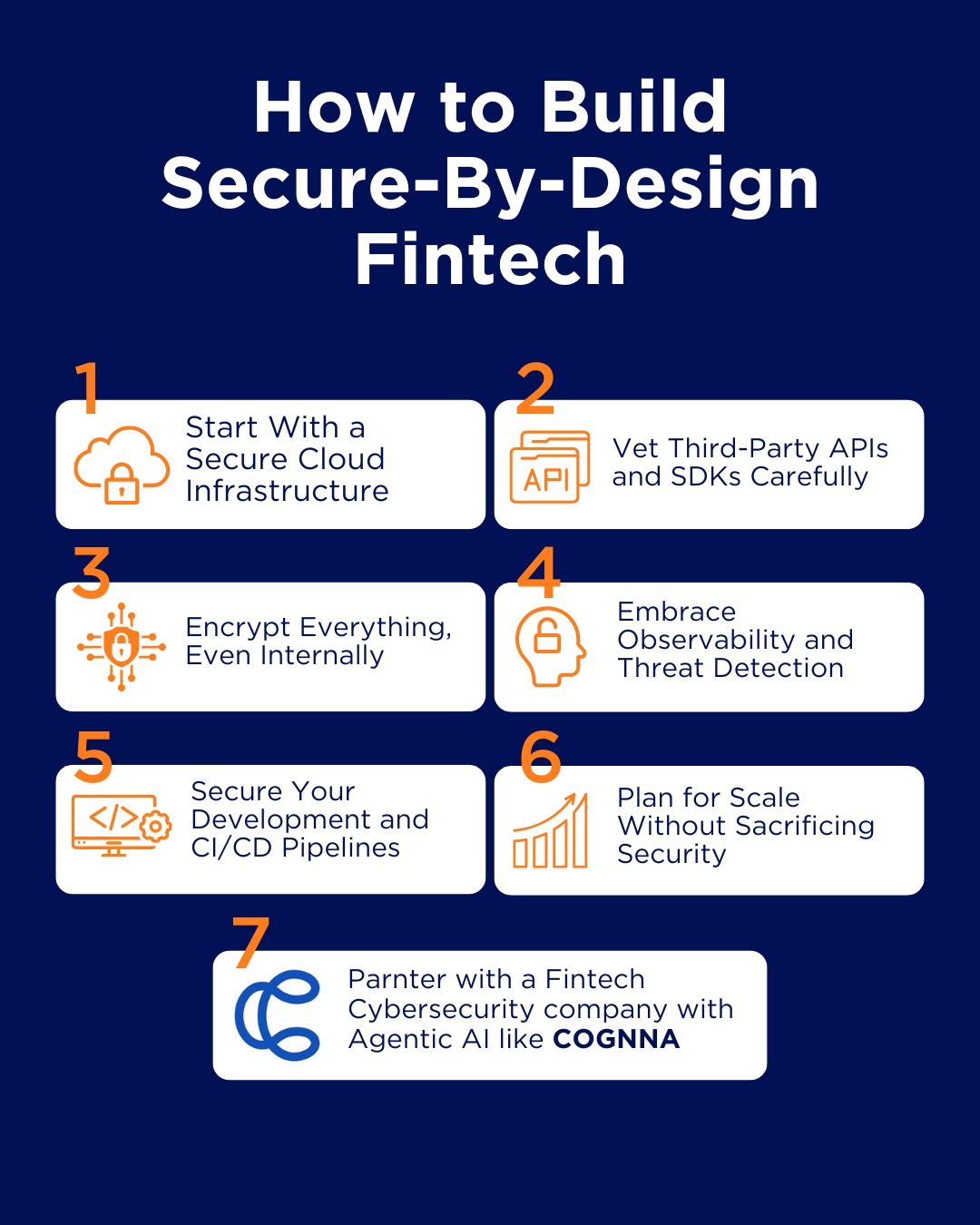Fintech Cybersecurity Essentials: Your 2025 Startup Guide

In fintech, speed is everything. Startups are under pressure to launch fast, integrate broadly, and scale globally. But as they stitch together cloud platforms, APIs, third-party vendors, and payment gateways, many are falling into a dangerous trap: the cybersecurity paradox.
The more tools you add, the more vulnerabilities you create.
This is especially risky in fintech, where companies handle highly sensitive financial data, manage real-time transactions, and operate in a tightly regulated environment. And yet, many of these fast-growing teams don’t have a dedicated security expert on board.
So how can you build a secure-by-design tech stack from day one?
This blog is your tech-centric guide, we’ll walk you through the essentials, from choosing secure cloud providers to encryption, API controls, and automated compliance strategies, to help your fintech startup grow with confidence, not risk.
What “Secure-by-Design” Means for Fintech Startups
Secure-by-design is more than a buzzword, it’s a mindset that treats security as an essential function, not a bolt-on feature.
For cybersecurity fintech companies (or fintechs building with security in mind), this means:
- Embedding security in your software development lifecycle (SDLC)
- Choosing vendors and providers who meet high security standards
- Using encryption, segmentation, and IAM (identity & access management) at every layer
- Automating threat detection and logging from day one
But secure design isn’t just about policies, it’s about embedding intelligence into how your systems behave. This is where newer technologies like Agentic AI come in: enabling platforms like COGNNA to detect, interpret, and even act on risks early, without adding friction to your product or team.
Startups that embrace secure-by-design with Agentic AI at the center don’t just check the compliance boxes. They gain a scalable, intelligent security posture that evolves as they grow.
Here’s your step-by-step guide to building secure-by-design Fintech.

1. Start With a Secure Cloud Infrastructure
Your cloud provider is your digital foundation. If it’s not secure, nothing you build will be.
When choosing a cloud platform, look for:
- Data residency control: Especially important in regions like Saudi Arabia or the GCC, where fintech regulators are strict about where data is stored.
- Encryption at rest and in transit: Ensure data is encrypted using strong protocols like AES-256 and TLS 1.2/1.3.
- IAM controls and fine-grained permissions: Use role-based access and zero-trust principles.
- Built-in security tools: Like AWS GuardDuty or Azure Security Center.
- SOC 2, ISO 27001, and GDPR compliance: Even if you’re not pursuing these certifications today, you may need to later.
Pro Tip: Don’t just trust the label. Verify your provider’s security documentation and audit logs.
2. Vet Third-Party APIs and SDKs Carefully
Fintech platforms often rely on third-party APIs for payment processing, KYC, credit scoring, and more. Each one introduces risk.
When evaluating these components:
- Check for rate limiting and abuse detection
- Ensure API data is encrypted and uses secure authentication (OAuth2, JWTs)
- Review security documentation and breach history
- Ask if the vendor offers signed SDKs, tokenized data, or obfuscation (Code scrambling)
Startups often trust a shiny API because it saves time. But if that API is breached, your customers, and your brand, pay the price.
3. Encrypt Everything, Even Internally
Encryption isn’t just about external threats. Many fintech cyber security breaches stem from internal misconfigurations or privilege misuse.
Build encryption into every layer of your tech stack:
- Databases: Use built-in encryption features (e.g., AWS KMS, Azure Key Vault)
- APIs and services: Encrypt payloads, even inside your own network
- Mobile apps: Use certificate pinning, secure storage (like Android Keystore, iOS Secure Enclave)
- Logs and backups: Often overlooked, these are prime targets for attackers
Don’t assume your firewall is enough. Assume compromise, and encrypt accordingly.
4. Embrace Observability and Threat Detection Early
Early-stage startups often skip logging or threat detection tools, assuming they’ll add them later. This is a mistake.
Fintech cybersecurity risks escalate fast when visibility is low. You need:
- Security Information and Event Management (SIEM) tools that scale
- Real-time alerting for suspicious behavior
- Agent-based telemetry that integrates with your DevOps stack
A modern solution like COGNNA makes this easy, even for startups with no security team.
5. Secure Your Development and CI/CD Pipelines
Your software pipeline is a high-value target. Developers are trusted users with powerful access.
Secure your dev environment by:
- Using signed code commits and pull request reviews
- Running SAST and DAST scans automatically
- Limiting access to production credentials
- Using secrets managers (not hardcoded keys!)
- Container scanning and dependency monitoring
By hardening your pipelines, you reduce one of the top fintech cybersecurity risks: supply chain compromise.
6. Plan for Scale Without Sacrificing Security
As your startup grows, your tech stack evolves. That doesn’t mean your security should lag behind.
Scalable cybersecurity in fintech means:
- Adopting modular tools that grow with your team and infrastructure
- Designing for multi-tenancy and data isolation from the start
- Avoiding vendor lock-in where possible, unless the vendor is part of your long-term security strategy
Why COGNNA Is Built for Startups Like Yours
At COGNNA, we’ve worked with fintech startups across the MENA region and understand the pressure you’re under: Ship fast, innovate faster, and stay secure in the face of regulators, attackers, and market expectations.
We’ve built a secure-by-design, AI-powered SOC platform that’s perfect for startups with zero internal security teams.
Here’s why:
- Agentic AI workflows: Our Agentic AI acts as your virtual SOC analyst, handling 99% of the noise so your team can focus on innovation.
- Prebuilt integrations: Our system integrates with various leading providers across multiple platforms, from cloud to databases.
- Affordable pricing: Our usage-based pricing scales with your business, no massive upfront costs or vendor lock-in. You only pay for what you use.
- Compliance-ready logs and dashboards: Stop dreading audits. We provide compliance-ready dashboards and logs for NCA and SAMA from day one.
Security shouldn’t slow your startup down. It should unlock growth.
Final Thoughts: Security Is Your Growth Engine
Founders and CTOs often treat security as a cost center. But in fintech, it’s a trust engine, and trust drives user growth, investor confidence, and long-term viability.
The earlier you build secure-by-design into your tech stack, the less time and money you’ll spend fixing vulnerabilities later.
.webp)
.webp)



